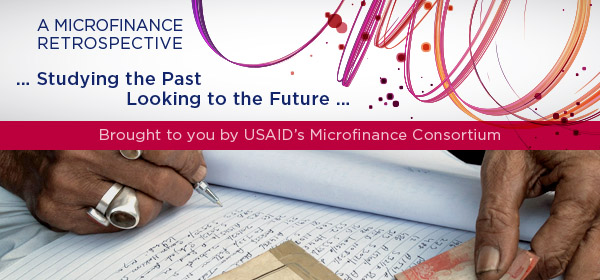Studying the Past, Looking to the Future: BancoSol: Moving Microfinance into the Mainline Financial System

Forward
While it was always the goal of the Agency's microfinance initiative to create private, profit making banks and credit unions to serve poor households, a lot of people were just not prepared for that point when the nongovernmental organizations (NGOs) being supported would transfer their assets to a new, for-profit company. This was especially true in the case of BancoSol, which was the very first bank transformed from an NGO supported by USAID. For Rich Rosenberg, who was seeing the results of microlending firsthand, it was a no-brainer. But for a development agency, transferring US government funds to a for-profit entity, these decisions are real handwringers. As NGO microfinance providers around the globe continue to transform, it is important to remember the BancoSol example, and the various roles people played to ensure success, including the role of letting go. – Anicca Jansen
BancoSol: Moving Microfinance into the Mainline Financial System
On February 2, 1992, BancoSol opened its doors, becoming the first commercial bank in the world dedicated exclusively to serving the microenterprise market. – World Bank
When I look in the rearview mirror at my 30-year career in the development racket (I say that with affection), BancoSol seems like the best project I was ever associated with. It pioneered a massive and long-lasting change that gave a large percentage of Bolivia's population access to formal financial services, and provided a model for financial inclusion elsewhere. The key to that evolution was moving microfinance into the mainline financial system by adopting a regulated bank structure that allowed it to capture commercial sources of funding, and to offer voluntary savings services to smaller depositors.
When I arrived in Bolivia in 1990, PRODEM (Fundacion para la Promocion y Desarrollo de la Microempresa) – BancoSol's NGO predecessor – already had a strong microlending program, and was thinking about a banking license. Two lessons stand out from the experience of watching the transformation process. First, an NGO-to-bank conversion ties up much more money and management attention than anyone would have expected. While it is going on, managers are limited in their ability to attend to the normal operational challenges of a growing business. Second, the leader who inspires and energizes the creation of a socially oriented NGO program will often (not always) have trouble adapting to the challenges of managing banking systems. In those days at least, if someone was running an NGO, you could speculate with reasonable confidence that their career choice was not driven by an ambition to be a banker.
Failure, the proverb goes, is an orphan, while success has many fathers (apologies for the sexist proverb). Whose were the essential contributions without which BancoSol would not have succeeded as it did? I make no claim to infallibility for the following list, but here are the people who stood out from my perspective:
- ACCION International first tried to introduce microcredit by partnering with existing in-country NGOs. This approach was non-imperialistic, and eminently politically correct. It just didn't work very well: None of those partnerships paid off in any major way. As I hear the story, it was Steve Gross, an ex-Jesuit ACCION staffer, who roamed around Latin America looking for high-quality individuals who might be interested in forming a new organization to pursue microfinance. Steve picked very well in Bolivia.
- My impression, subject to correction by others involved in ACCION at the time, is that Bill Tucker and Bob Christen were instrumental in focusing ACCION on the then-radical idea that microcredit could and should be delivered on a businesslike, sustainable basis.
- Pancho Otero was the visionary, determined, energetic, inspirational, and – yes – quirky Bolivian genius who built the original microlending operation. More than anyone else, he's the guy who made it all happen.
- Martin Connell and Doug Salloum of Canada's Calmeadow Foundation provided essential strategic and operational support for the much-more-difficult-than-expected process (led by Miguel Taborga) of transferring operations to a new licensed bank.
- Lucho del Rio, the superintendent of banks, saw the possibilities for Bolivian financial inclusion and supported them through a practice of "regulation by winking," that is, temporarily ignoring some banking rules that would have made licensing BancoSol very difficult.
- The BancoSol board of directors, a group of outstanding Bolivians who among many other things took the political risk of being associated with a bank that "gouged the poor" with higher interest rates, and had the courage to replace their good friend Pancho Otero when the management of the new bank required it.
That's where my list ends. Obviously, the subsequent management and board of BancoSol deserve a lot of credit, but I was not close enough to the action then to identify the stars.
And where on this list does USAID belong? I think my Agency played an honorable but not essential role. If my decades of experience with microfinance have taught me anything, it is that pioneering financial inclusion work is created by managers, not donors. When it comes to supporting retail financial access innovations, the main role of funders is to make smart bets in picking managers. My predecessors in the USAID Mission made a smart bet on the PRODEM team. But if they hadn't done so, I suspect PRODEM would have found support elsewhere.
My own credibility in microfinance certainly benefited from some reflected glory over the years because I was the USAID project manager during the time of the BancoSol conversion. But if you put my hand on the Bible, the only role that I'm confident in claiming is that I kept the USAID bureaucracy out of BancoSol's way. Honorable, yes. Essential, no.

